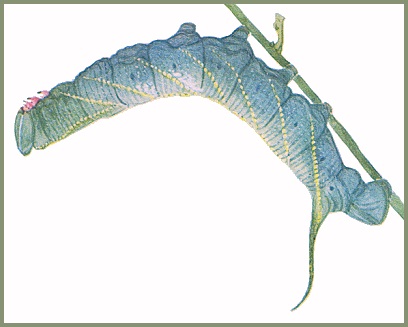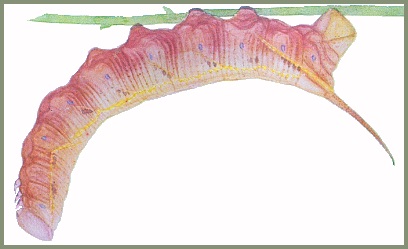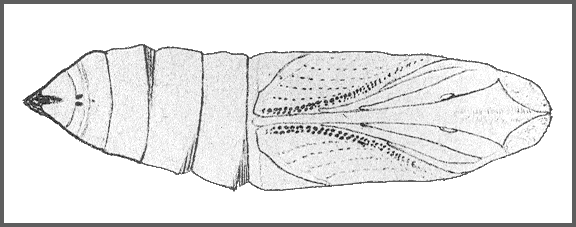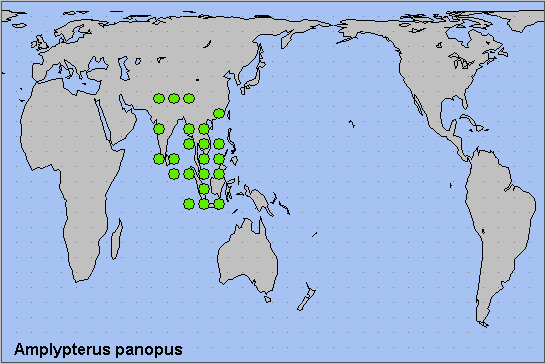

Sphinx panopus Cramer, 1779, Uitlandsche Kapellen (Papillons exot.) 3: 50, pl. 224, figs A, B. Type locality: [Indonesia,] Java [Jawa Tengah], Samarang [Semarang].
Synonym. Sphinx panopus Cramer, 1779.
Synonym. Calymnia pavonica Moore, 1877.
Wingspan: 130--168mm. Superficially similar to species of the Adhemarius dariensis species-group but Amplypterus panopus panopus is distinctive in the broad, sharply delineated, parallel-sided, ash-pink band across the forewing and similarly coloured broad markings on the anterior half of the abdomen. These bands contrast with the dark chocolate-brown colour of the thorax, forewing bases and distal half of the abdomen. When resting, the wings are spread widely in a plane below the horizontal, the forewings not quite covering the hindwings, the latter just covering the sides of the abdomen. In this position the moth is a wonderful example of protective colouring. These bands divide the moth into three stripes, two dark bands separated by a pale band. Apex broadly of hindwing rounded (pointed in Amplypterus mansoni).
Unlike Adhemarius dariensis and its relatives, the forewing upperside of Amplypterus panopus panopus lacks the subbasal spot and the tornal patch is developed into a poorly defined eyespot; tornal eyespot better developed than in Amplypterus mansoni and the submarginal area above it with a stronger, more contrasted pattern. Outer third of hindwing upperside has a diagnostic pattern of black veins crossing an olive-green submarginal and blue-grey marginal band.
In the male genitalia, uncus with a spatulate median process. Gnathos produced into a median plate, slightly longer than broad. Valve very large, apex rounded; stridulatory scales present. Harpe a small basal ridge standing nearly at right-angles to ventral edge of valve. Phallus with a small tooth; apex with two lingulate flaps bearing setose triangular projections. In the female genitalia, sterigma membranous except for the strongly rounded distal edge.




The moth is sluggish during the daytime and allows itself to be handled, but at night it flies strongly. It has never been seen feeding at flowers, nor does it seem to come readily to light, though Mell states that it has frequently been caught at light in Java. It emerges from the pupa after dark, and pairs after midnight when in captivity. In India, Bell & Scott (1937) exposed bred females at about 1,500' altitude and attracted eight males over four nights between 03.00 and 04.00h. Attempts to breed this species in captivity may fail, the males and females often refusing to pair (Bell & Scott, 1937).
A woodland species in Hong Kong (Kendrick, 2002).
China: iii (Yunnan); iii-iv (Guangdong; Hong Kong); vi (Guangxi; Jiangxi; Hainan); vi-vii (Yunnan; Guizhou); 23.vii (Yunnan); viii (Fujian; Hong Kong; Zhejiang; Hainan); 28.xi (Hainan).
Kendrick (2002) gives March, April, June, August and December for Hong Kong.
OVUM: Yellow and oval (2.60 x 2.15mm). Surface smooth and shiny. Laid singly on the underside of a leaf (Bell & Scott, 1937).
LARVA: Full-fed 110mm long, 16mm wide; horn 20mm. According to Bell & Scott (1937), in the third instar head triangular, a spiniform process rising from vertex of each lobe, the two processes appressed into a long cone-shaped extension two-thirds the length of the head. Surface of head smooth, covered sparsely with small tubercles; the processes shiny and set with pointed tubercles. Body nearly cylindrical, tapering slightly from segment 5 frontad; surface smooth, with a dorso-lateral line of pointed tubercles on segments 2 to 11. Horn very long, thin, sharply pointed, curved gently upwards; surface shiny and covered with small tubercles. Colour of head glaucous-green with a yellow cheek-stripe from the vertex to base of antenna and from vertex to nape. Body white above the longitudinal line of tubercles, with a broad green dorsal stripe, grass green below the line of tubercles; the tubercles yellow on segments 2 to 4 and then white. There are yellow oblique lateral stripes on segments 5 to 11. Horn dark brown dorsally, yellowish ventrally. True legs brown, prolegs and claspers green, anal flap and claspers edged with yellow (Bell & Scott, 1937).
In the final and fifth instar, head triangular, higher than broad, vertex slightly truncate, without apical processes. Clypeus one-half length of head, sunken, apex rounded, basal angles tumid; no false clypeus. Ligula trapeze-shaped, widening frontad, the sinus wide and deep. Surface of head shiny, very shallowly corrugate and set with sparse, irregularly-spaced, small, circular tubercles. Body tapering slightly from segment 7 frontad, flattened laterally from segment 8 to 12; surface dull. Horn long, thick at base, tapering evenly to a sharp point, basal half horizontal, distal half gently up-curved. There is a transverse row of small, sharply pointed, conical tubercles on each secondary ring and a dorso-lateral line of large tubercles on segments 2 to 11, as in the third instar. The oblique lateral stripe on segment 11 is set with large tubercles.
In the green form, head glaucous-green, with a dorsal stripe from the vertex to apex of clypeus, then dividing and running down sides of clypeus; a cheek-stripe separating face from cheek; a subdorsal stripe from vertex to nape, where it joins the subdorsal line of tubercles on the body; all these stripes narrow and yellow. Labrum glassy-greenish; ligula greenish; basal segment of antenna yellowish-green, other segments pale reddish-brown; mandible violet, tip brown. Body grass-green, dorsum glaucous-white; tubercles and oblique lateral stripes yellow. Horn glaucous-green. Legs pink, prolegs and claspers green. Anal flap and claspers green edged with yellow. Spiracles oval, flush, violet-grey with a narrow blue central slit. There are also reddish-brown and yellow forms (see below).
The larva lives on the underside of a leaf, generally choosing one in a dense cluster. It lies stretched out straight when at rest, is sluggish, and feeds chiefly at night. Before leaving the hostplant to pupate it becomes suffused with brown-pink, and later is somewhat greasy looking (Bell & Scott, 1937).






PUPA: 58--75mm long, 16mm wide. Stout in build. Dark red-brown in colour, but nearly black on segments 1 to 3 and on 13 and 14. Vertex of head at right angles to the axis of the pupa. Tongue reaches to tip of wing-case, fore-leg to about the middle of wing-case; antenna slightly shorter and mid-leg slightly longer. There is a small coxal piece. Surface moderately shiny, coarsely and shallowly rugose, with minute tubercles on the rugosities. Costal margins of wings beaded, sculpturing on segment 4 a bracket-shaped, transverse, narrow, shiny line on each side of dorsum. Segment 4 also deeply transversely furrowed by two broad parallel channels. Segments 5, 6 and 7 each with three depressed lines parallel with their margins. There are ante-spiracular ridges on segments 9 to 11 in the form of four parallel ridges on each. Front margins of 9 to 11 tumid behind the bevelled portions, the tumidity deeply pitted. Spiracle of 2 indicated by a long, flat, narrow, black strip on front margin of thorax, with a crescent-shaped slit in front of it; the other spiracles sunken ovals with raised centres. Cremaster short and triangular, constricted near base, surface shiny and rugose, with a deep hollow on each side of the ventral surface penetrating to the dorsal surface and thus making a perforation (Bell & Scott, 1937).
Pupation is in a cell underground. The pupal stage lasts about three weeks except in the case of hibernating pupae, when it may last as many months or even longer.


Larval hostplants. Recorded from Dracontomelon, Mangifera indica, Rhus, Durio, Calophyllum and Garcinia (Bell & Scott, 1937; Inoue, Kennett & Kitching, [1996] 1997). In recent years it has become a pest of Eucalyptus trees in Guangxi, China (Luo et al., 2015).
In Metro-Manila, the Philippines, larvae can be common on parkland and roadside mango trees (Mangifera indica) (Dvořák, 2014).
[This species has been successfully reared in captivity on Tsuga, Pseudotsuga, Juniperus and Pistachia (Serge Yevdoshenko, pers. comm. 2025).]
China: Zhejiang (Kuocang Mountain Nature Reserve; Wuyanling National Nature Reserve); Chongqing (Chongqing); Yunnan (Huanglian Shan, Lüchun, 1900m; Mengla County, Mt. Leigongyan, 2000m; Gaoligong Shan; Simao/Pu'er; Baka Xiaozhai, Menglun); Guizhou (Fanjingshan, Tongren County; Xinzhaidashan, Zhijin County, 1000-2000m; Libo County); Hunan; Jiangxi (Le'an); Fujian (Guangze, 1200m; Longqi Shan); Guangdong (Guangzhou); Guangxi (Guiping Station, Longtan National Forest Park; Maoer Shan, 1800m); Hong Kong; Hainan (Duowen Ling, nr Lingao; Longhushan, Wenchang City; Wuzhishan; nr Dumu Chenglin).
Sri Lanka, southern and northern India (including the Andaman and Nicobar Islands (Kailash Chandra & Rajan, 2004; Singh, Ahmad & Chandra, 2021)), Nepal, Bhutan (Irungbam & Irungbam, 2019), Burma/Myanmar, southern China, Thailand, Vietnam (Le & Vu, 2024), Indonesia (to Sulawesi, Timor and Seram) and the Philippines.

 Return to Sphingidae of the Eastern Palaearctic species list
Return to Sphingidae of the Eastern Palaearctic species list